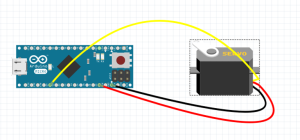Fall 2015 MicroBiPed Microcontroller
MICROCONTROLLER TRADE-OFF
By Railly Mateo (Systems Engineer)
Approved by Paul Oo (Project Manager)
Approved by Railly Mateo (Systems Engineer)

|
Microcontroller |
PWM Digital I/O pins |
Analog Input pins |
Input Voltage |
Dimension |
Flash & SRAM |
Price |
|
Arduino Micro ATmega32u4 |
6 |
6 |
7 – 12V |
68.6 x 53.4 mm |
32 kB & 2 kB |
$9.00 |
|
Arduino Uno ATmega328 |
7 |
12 |
7-12V |
48 x 18 mm |
32 kB & 2.5 kB |
$25.00 |
The above table compares 2 possible microcontrollers to use for the µBiPed project. The chart compares pins, input voltage, dimension, memory, and average price.
- The amount of pins available for analog and digital I/O’s are important because of the amount of sensors and servos the microcontroller will be connected to.
- We will need to connect 8 servos to analog pins on the microcontroller.
- We will need to connect 2 PWM pins to the payload.
- Input Voltage is used for understanding the amount of voltage the batteries must supply.
- The dimensions are key to creating a transparent embedded system.
- Pricing is desired to lower the cost of the total budget.
After comparing the microcontrollers, the group decided on using the Arduino Micro for the purpose of having a smaller and most cost efficient microcontroller.
- Although the Arduino Uno has more pins, our BiPed will need no more than 8 PWM pins for our 8 servos.
- The microprocessors are also differentiated as either through-hole or surface mount. Considering that the 32u4 is a surface mount microprocessor, it has the advantage in compact design.
- Lastly, while the Uno has low margins for cost differentiation, the Micro ranges from $8.00 to $22.00. The difference in price is the main determinant for why the Arduino Micro was chosen.
